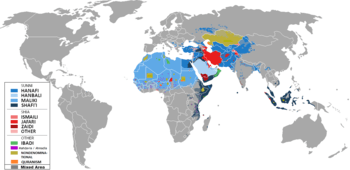Islam in Pakistan
Islam is the largest and the state religion of the Islamic Republic of Pakistan.[4] Pakistan has been called a "global center for political Islam".[5]
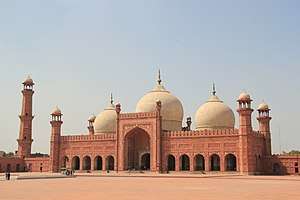 Badshahi Masjid, a symbolic Islamic monument built during Mughal Era (1673). | |
| Total population | |
|---|---|
| c. 200 million (96.3%)[1] | |
| Regions with significant populations | |
| Throughout Pakistan | |
| Religions | |
| Islam Majority: Sunni Minority: non-denominational Muslim, Quranist, Shia | |
| Languages | |
| Islam in Pakistan | ||||||
|---|---|---|---|---|---|---|
.jpg) | ||||||
| History | ||||||
|
||||||
| Major figures | ||||||
|
||||||
| Schools of thought | ||||||
| Schools of law | ||||||
| Mosques | ||||||
| Political organisations / movements | ||||||
|
||||||
| Culture | ||||||
|
||||||
| Other topics | ||||||
|
||||||
| ||||||
Islam in Pakistan existed in communities along the Arab coastal trade routes in Sindh as soon as the religion originated and had gained early acceptance in the Arabian Peninsula. The connection between the Sind and Islam was established by the initial Muslim missions during the Rashidun Caliphate. Al-Hakim ibn Jabalah al-Abdi, who attacked Makran in the year 649 AD, was an early partisan of Ali ibn Abu Talib. During the caliphate of Ali, many Hindus of Sindh had came under influence of Islam and some even participated in the Battle of Camel and died fighting for Ali. Under the Umayyads (661 - 750 AD), many Shias sought asylum in the region of Sindh, to live in relative peace in the remote area. Ziyad Hindi is one of those refugees. In 712 CE, a young Arab general Muhammad bin Qasim conquered most of the Indus region for the Umayyad empire, to be made the "As-Sindh" province with its capital at Al-Mansurah.[6][7][8][9][10] By the end of the 10th century CE, the region was ruled by several Hindu Shahi kings who would be subdued by the Ghaznavids.
About 97% of Pakistanis are Muslims.[11] Pakistan has the second largest number of Muslims in the world after Indonesia.[12][13] The majority are Sunni (90%)[14][15][16][17][18] while Shias make up between 5-7%[19][20][21][22][23]. Smaller minority Muslim populations in Pakistan include Quranists, nondenominational Muslims.[24] There are also two Mahdi'ist based creeds practiced in Pakistan, namely Mahdavia and Ahmadis[25], the latter of whom is considered by the constitution of Pakistan to be non-Muslims are constitute 1% of Muslims.[26]
Islam before the Independent Pakistan
The Arab conqueror Muhammad bin Qasim conquered Sindh in 711 CE.[6][27][28][29][30] The Pakistan government's official chronology claims this as the time when the foundation of Pakistan was laid[6][31][32] but the concept of Pakistan came in 19th century.The Early Medieval period (642–1219 CE) witnessed the spread of Islam in the region. During this period, Sufi missionaries played a pivotal role in converting a majority of the regional Buddhist and Hindu population to Islam.[33] These developments set the stage for the rule of several successive Muslim empires in the region, including the Ghaznavid Empire (975–1187 CE), the Ghorid Kingdom, and the Delhi Sultanate (1206–1526 CE). The Lodi dynasty, the last of the Delhi Sultanate, was replaced by the Mughal Empire (1526–1857 CE).
Islam in independent Pakistan
Nature of state
The Muslim League leadership, ulama (Islamic clergy) and Jinnah had articulated their vision of Pakistan in terms of an Islamic state.[34] Muhammad Ali Jinnah had developed a close association with the ulama.[35] When Jinnah died, Islamic scholar Maulana Shabbir Ahmad Usmani described Jinnah as the greatest Muslim after the Mughal Emperor Aurangzeb and also compared Jinnah's death to the Prophet's passing.[35] Usmani asked Pakistanis to remember Jinnah's message of Unity, Faith and Discipline and work to fulfil his dream:
to create a solid bloc of all Muslim states from Karachi to Ankara, from Pakistan to Morocco. He [Jinnah] wanted to see the Muslims of the world united under the banner of Islam as an effective check against the aggressive designs of their enemies.[35]
The first formal step taken to transform Pakistan into an ideological Islamic state was in March 1949 when the country's first Prime Minister, Liaquat Ali Khan, introduced the Objectives Resolution in the Constituent Assembly.[36] The Objectives Resolution declared that sovereignty over the entire universe belongs to God Almighty.[37] The president of the Muslim League, Chaudhry Khaliquzzaman, announced that Pakistan would bring together all Muslim countries into Islamistan-a pan-Islamic entity.[38] Khaliq believed that Pakistan was only a Muslim state and was not yet an Islamic state, but that it could certainly become an Islamic state after bringing all believers of Islam into a single political unit.[39] Keith Callard, one of the earliest scholars on Pakistani politics, observed that Pakistanis believed in the essential unity of purpose and outlook in the Muslim world:
Pakistan was founded to advance the cause of Muslims. Other Muslims might have been expected to be sympathetic, even enthusiastic. But this assumed that other Muslim states would take the same view of the relation between religion and nationality.[38]
However, Pakistan's pan-Islamist sentiments were not shared by other Muslim governments at the time. Nationalism in other parts of the Muslim world was based on ethnicity, language and culture.[38] Although Muslim governments were unsympathetic with Pakistan's pan-Islamic aspirations, Islamists from all over the world were drawn to Pakistan. Figures such as the Grand Mufti of Palestine, Al-Haj Amin al-Husseini, and leaders of Islamist political movements, such as the Muslim Brotherhood, became frequent visitors to the country.[40] After General Zia-ul-Haq took power in a military coup, Hizb ut-Tahrir (an Islamist group calling for the establishment of a Caliphate) expanded its organisational network and activities in Pakistan. Its founder, Taqi al-Din al-Nabhani, would maintain regular correspondence with Abul A’la Maududi, the founder of Jamaat-e-Islami (JI), and he also urged Dr Israr Ahmed to continue his work in Pakistan for the establishment of a global caliphate.[41]
Social scientist Nasim Ahmad Jawed conducted a survey in 1969 in pre-divided Pakistan on the type of national identity that was used by educated professional people. He found that over 60% of people in East Pakistan (modern day Bangladesh) professed to have a secular national identity. However, in West Pakistan (current day Pakistan) the same figure professed to have an Islamic and not a secular identity. Furthermore, the same figure in East Pakistan defined their identity in terms of their ethnicity and not Islam. It was the opposite in West Pakistan, where Islam was stated to be more important than ethnicity.[42]
After Pakistan's first ever general elections the 1973 Constitution was created by an elected Parliament.[43] The Constitution declared Pakistan an Islamic Republic and Islam as the state religion. It also stated that all laws would have to be brought into accordance with the injunctions of Islam as laid down in the Quran and Sunnah and that no law repugnant to such injunctions could be enacted.[44] The 1973 Constitution also created certain institutions such as the Shariat Court and the Council of Islamic Ideology to channel the interpretation and application of Islam.[45]
Zia ul Haq's Islamization
On 5 July 1977, General Zia-ul-Haq led a coup d'état.[46] In the year or two before Zia-ul-Haq's coup, his predecessor, leftist Prime Minister Zulfikar Ali Bhutto, had faced vigorous opposition which was united under the revivalist banner of Nizam-e-Mustafa[47] ("Rule of the prophet"). According to supporters of the movement, establishing an Islamic state based on sharia law would mean a return to the justice and success of the early days of Islam when the Islamic prophet Muhammad ruled the Muslims.[48] In an effort to stem the tide of street Islamisation, Bhutto had also called for it and banned the drinking and selling of wine by Muslims, nightclubs and horse racing.[48][49]
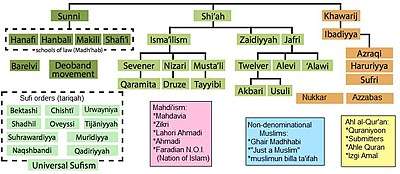
"Islamisation" was the "primary" policy,[50] or "centerpiece"[51] of his government. Zia-ul-Haq committed himself to establishing an Islamic state and enforcing sharia law.[48] Zia established separate Shariat judicial courts[45] and court benches[52][53] to judge legal cases using Islamic doctrine.[54] New criminal offences (of adultery, fornication, and types of blasphemy), and new punishments (of whipping, amputation, and stoning to death), were added to Pakistani law. Interest payments for bank accounts were replaced by "profit and loss" payments. Zakat charitable donations became a 2.5% annual tax. School textbooks and libraries were overhauled to remove un-Islamic material.[55] Offices, schools, and factories were required to offer praying space.[56] Zia bolstered the influence of the ulama (Islamic clergy) and the Islamic parties,[54] whilst conservative scholars became fixtures on television.[56] 10,000s of activists from the Jamaat-e-Islami party were appointed to government posts to ensure the continuation of his agenda after his passing.[48][54][57][58] Conservative ulama (Islamic scholars) were added to the Council of Islamic Ideology.[52] Separate electorates for Hindus and Christians were established in 1985 even though Christian and Hindu leaders complained that they felt excluded from the county's political process.[59]
Zia's state sponsored Islamization increased sectarian divisions in Pakistan between Sunnis and Shias and between Deobandis and Barelvis.[60] A solid majority of Barelvis had supported the creation of Pakistan,[61] and Barelvi ulama had also issued fatwas in support of the Pakistan Movement during the 1946 elections,[62][63] but ironically Islamic state politics in Pakistan was mostly in favour of Deobandi (and later Ahl-e-Hadith/Salafi) institutions.[64] This was despite the fact that only a few (although influential) Deobandi clerics had supported the Pakistan Movement.[64] Zia-ul-Haq forged a strong alliance between the military and Deobandi institutions.[64]
Possible motivations for the Islamization programme included Zia's personal piety (most accounts agree that he came from a religious family),[65] desire to gain political allies, to "fulfill Pakistan's raison d'être" as a Muslim state, and/or the political need to legitimise what was seen by some Pakistanis as his "repressive, un-representative martial law regime".[66]
Until the government of General Muhammad Zia-ul-Haq, "Islamic activists" were frustrated by the lack of "teeth" to enforce Islamic law in Pakistan's constitution. For example, in the 1956 constitution, the state did not enforce "Islamic moral standards" but "endeavor[ed]" to make them compulsory and to "prevent" prostitution, gambling, consumption of alcoholic liquor, etc. Interest was to be eliminated "as soon as possible".[67][68]
According to Shajeel Zaidi a million people attended Zia ul Haq's funeral because he had given them what they wanted: more religion.[69] A PEW opinion poll found that 84% of Pakistanis favoured making Sharia the official law of the land.[70] According to the 2013 Pew Research Center report, the majority of Pakistani Muslims also support the death penalty for those who leave Islam (62%). In contrast, support for the death penalty for those who leave Islam was only 36% in fellow South Asian Muslim country Bangladesh (which shared heritage with Pakistan).[71] A 2010 opinion poll by PEW Research Centre also found that 87% of Pakistanis considered themselves 'Muslims first' rather than a member of their nationality. This was the highest figure amongst all Muslim populations surveyed. In contrast only 67% in Jordan, 59% in Egypt, 51% in Turkey, 36% in Indonesia and 71% in Nigeria considered themselves as 'Muslim first' rather than a member of their own nationality.[72]
"Islamic activists" such as much or the ulama (Islamic clerics) and Jamaat-e-Islami (Islamist party), support the expansion of "Islamic law and Islamic practices". "Islamic Modernists" are lukewarm to this expansion and "some may even advocate development along the secularist lines of the West."[73]
Islamic way of life
The mosque is an important religious as well as social institution in Pakistan.[74][75] Many rituals and ceremonies are celebrated according to Islamic calendar.
Muslim fiqhs in Pakistan
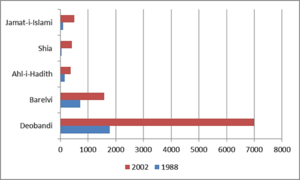

According to the CIA World Factbook and Oxford Centre for Islamic Studies, 95-97% of the total population of Pakistan is Muslim.[11]
Sunni
The majority of the Pakistani Muslims belong to the Sunni Hanafi Madhhab (school of jurisprudence).[77] Estimates on the Sunni population in Pakistan range from 85% to 90%.[14][15][16][17][18]
Shia
Shia Ithna 'ashariyah are estimated to be 5–7% of the country's population.[15][78][22][23] Pakistan, like India, is said to have at least 5-7% Shias.[23][79][80]
Shias allege discrimination by the Pakistani government since 1948, claiming that Sunnis are given preference in business, official positions and administration of justice.[81] Attacks on Shias increased under the presidency of Zia-ul-Haq,[81] with the first major sectarian riots in Pakistan breaking out in 1983 in Karachi and later spreading to Lahore and Balochistan.[82] Sectarian violence became a recurring feature of the Muharram month every year, with sectarian violence between Sunnis and Shias taking place in 1986 in Parachinar.[82] In one notorious incident, the 1988 Gilgit Massacre, Osama bin Laden-led Sunni tribals assaulted, massacred and raped Shia civilians in Gilgit after being inducted by the Pakistan Army to quell a Shia uprising in Gilgit.[83][84][85][86][87]
Sufism
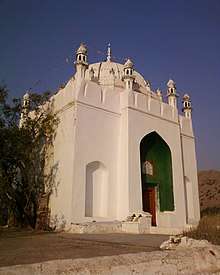
Sufism is a vast term and many Sufi orders exist within Pakistan where the philosophy has a strong tradition. Historically, the Sufi missionaries had played a pivotal role in converting the native peoples of Punjab and Sindh to Islam.[88] The most notable Muslim Sufi orders in Pakistan are the Qadiriyya, Naqshbandiya, Chishtiya and Suhrawardiyya silsas (Muslim Orders) and they have a large amount of devotees in Pakistan. The tradition of visiting dargahs is still practiced today. Sufis whose shrines receive much national attention are Data Ganj Baksh (Ali Hajweri) in Lahore (ca. 11th century), Sultan Bahoo in Shorkot Jhang, Baha-ud-din Zakariya in Multan and Shahbaz Qalander in Sehwan (ca. 12th century) and Shah Abdul Latif Bhitai in Bhit, Sindh and Rehman Baba in Khyber Pakhtunkhwa Province. The Urs (death anniversary) of Sufi saints accounts for the largest gathering upon their shrines held annually by the devotees.
Although, popular Sufi culture is centered on Thursday night gatherings at shrines and annual festivals which feature Sufi music and dance, certain tariqas such as Sarwari Qadri Order, refrain from such traditions and believe in paying visit to the shrines, making prayers or reciting manqabat. Moreover, contemporary Islamic fundamentalists also criticize the popular tradition of singing, dance and music, which in their view, does not accurately reflect the teachings and practice of the Prophet Mohammad and his companions. There have been terrorist attacks directed at Sufi shrines and festivals, five in 2010 that killed 64 people. Presently, the known tariqas in Pakistan have maintained their organisations usually known as tehreeks and have their khanqahs for the dhikr of Allah, as per the old age Sufi tradition.[89][90]
Quranists
Muslims who reject the authority of hadith, known as Quranist, Quraniyoon, or Ahle Quran, are also present in Pakistan.[91] The largest Quranist organization in Pakistan is Ahle Quran, followed by Bazm-e-Tolu-e-Islam. Another Quranist movement in Pakistan is Ahlu Zikr.[24]
Nondenominational
Roughly twelve per cent of Pakistani Muslims self-describe or have beliefs overlapping with non-denominational Muslims. These Muslims have beliefs that by and large overlap with those of the majority of Muslims and the difference in their prayers are usually non-existent or negligible. Nonetheless, in censuses asking for a clarification on which strand or rite of Muslim faith they most closely align, they usually answer "just a Muslim".[92]
Mahdavia & Ahmadiyya
The are two main Mahdi'ist-based creeds practised in Pakistan, Mahdavia and Ahmadiyya. The former, Mahdavia, has been practised in modern-day Pakistan since the 15th century. Mahdavis consider Syed Jaunpari to be the Mahdi prophecised in Muslim canons.[25] The minority group Ahmadiyya is also present. In 1974, the government of Pakistan amended the Constitution of Pakistan to define a Muslim "as a person who believes in finality of Prophet Muhammad" and technically Ahmadis are declared non-Muslims.[93] Ahmadis believe in Muhammad as the best and the last law bearing prophet and Mirza Ghulam Ahmad as the Christ of Muslims. Consequently, they were declared non-Muslims by a parliamentary tribunal. There are approximately 2 million Ahmadis in the country. This equates to around 1% of the population.[26]
Conversions
There have been conversions to Islam from the religious minorities of Pakistan. Baba Deen Mohammad Shaikh, a former Hindu, is a Muslim missionary from Matli in Badin District of Sindh province and has converted over 110,000 Hindus to Islam.[94]
There are Christian missionaries active in Pakistan trying to convert Muslims. The Daily Pakistan in 2017 reported that the South Korean missionaries are involved in evangelising in Muslim countries like Pakistan.[95]In 2014, four Christian missionaries were arrested for distributing Christian pamphlets in the Mirpurkhas in Sindh.[96] In 2017, a Christian missionary couple sent by the British Pakistani Christian Association on a missionary trip to Pakistan was forced to leave Pakistan.[97] In 2017, two christian missionaries preaching in Pakistan were killed by militants.[98]
Gallery
_-_Walters_W5967A_-_Full_Page.jpg) The first Mughal Emperor Babur before crossing the Indus River
The first Mughal Emperor Babur before crossing the Indus River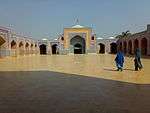 Shah Jahan Mosque, Thatta was patronized by the Mughal Emperor Shah Jahan.
Shah Jahan Mosque, Thatta was patronized by the Mughal Emperor Shah Jahan.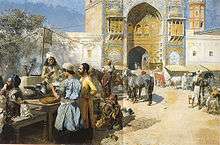 A painting by Edwin Lord Weeks c. 1889 of the marketplace near Wazir Khan Mosque
A painting by Edwin Lord Weeks c. 1889 of the marketplace near Wazir Khan Mosque
See also
- Baad (practice)
- Blasphemy law in Pakistan
- Forced conversion to Islam in Pakistan
- Freedom of religion in Pakistan
- History of the Islamic Republic of Pakistan
- Islam in South Asia
- Islamization in Pakistan
- Jamaat-e-Islami Pakistan
- Religion in Pakistan
- Religious discrimination in Pakistan
- Shia Islam in Pakistan
- Sufism in Pakistan
- Sufism in Sindh
- Vani (custom)
Further reading

- Raja, Masood Ashraf. Constructing Pakistan: Foundational Texts and the Rise of Muslim National Identity, 1857–1947, Oxford 2010, ISBN 978-0-19-547811-2
- Zaman, Muhammad Qasim. Islam in Pakistan: A History (Princeton UP, 2018) online review
References
- "POPULATION BY RELIGION" (PDF). www.pbs.gov.pk. Retrieved 2019-01-15.
- Al-Jallad, Ahmad. "Polygenesis in the Arabic Dialects". Cite journal requires
|journal=(help) - https://www.pewforum.org/2012/08/09/the-worlds-muslims-unity-and-diversity-1-religious-affiliation/#identity
- "Population: 207,774,520 (July 2017)". The World Factbook. Central Intelligence Agency. 2012. Retrieved 2012-05-26.
- Ḥaqqānī, Husain (2005). Pakistan: between mosque and military. Washington: Carnegie Endowment for International Peace. p. 131. ISBN 0-87003-214-3. Retrieved 23 May 2010.
Zia ul-Haq is often identified as the person most responsible for turning Pakistan into a global center for political Islam. ...
- "History in Chronological Order". Ministry of Information and Broadcasting, Government of Pakistan. Archived from the original on 23 July 2010. Retrieved 15 January 2010.
- "Figuring Qasim: How Pakistan was won". Dawn. 2012-07-19. Retrieved 19 February 2015.
- "The first Pakistani?". Dawn. Retrieved 19 February 2015.
- "Muhammad Bin Qasim: Predator or preacher?". Dawn. 2014-04-08. Retrieved 19 February 2015.
- Paracha, Nadeem F. "Why some in Pakistan want to replace Jinnah as the founder of the country with an 8th century Arab". Scroll.in. Retrieved 2018-01-09.
- "Pakistan, Islam in". Oxford Centre for Islamic Studies. Oxford University Press. Retrieved 2010-08-29.
Approximately 97 percent of Pakistanis are Muslim. The majority 90 percent are Sunnis following the Hanafi school of Islamic law. Between 5-7 percent are Shias, mostly Twelvers.
- Singh, Dr. Y P (2016). Islam in India and Pakistan – A Religious History. Vij Books India Pvt Ltd. ISBN 9789385505638.
- see: Islam by country
- "Country Profile: Pakistan" (PDF). Library of Congress Country Studies on Pakistan. Library of Congress. February 2005. Retrieved 2010-09-01.
Religion: The overwhelming majority of the population (96.3 percent) is Muslim, of whom approximately 90 percent are Sunni and 5-7 percent Shia.
- "Religions: Muslim 95% (Sunni 90%, Shia 5%), other". Pakistan (includes Christian and Hindu) 5%. The World Factbook. CIA. 2010. Retrieved 2010-08-28.
- "Mapping the Global Muslim Population: A Report on the Size and Distribution of the World's Muslim Population". Pew Research Center. October 7, 2009. Retrieved 2010-08-28.
- Miller, Tracy, ed. (October 2009). Mapping the Global Muslim Population: A Report on the Size and Distribution of the World's Muslim Population (PDF). Pew Research Center. Archived from the original (PDF) on 2009-10-10. Retrieved 2010-08-28.
- "Pakistan - International Religious Freedom Report 2008". United States Department of State. Retrieved 2010-08-28.
- "Country Profile: Pakistan" (PDF). Library of Congress Country Studies on Pakistan. Library of Congress. February 2005. Retrieved 2010-09-01.
Religion: The overwhelming majority of the population (96.3 percent) is Muslim, of whom approximately 90 percent are Sunni and 5 percent Shia.
- "Religions: Muslim 95% (Sunni 90%, Shia 5%), other". Pakistan (includes Christian and Hindu) 5%. The World Factbook. CIA. 2010. Retrieved 2010-08-28.
- "Country Profile: Pakistan" (PDF). Library of Congress Country Studies on Pakistan. Library of Congress. February 2005. Retrieved 2010-09-01.
Religion: The overwhelming majority of the population (96.3 percent) is Muslim, of whom approximately 95 percent are Sunni and 5 percent Shia.
- "The World's Muslims: Unity and Diversity". Pew Research Center. 9 August 2012. Retrieved 26 December 2016.
On the other hand, in Pakistan, where 6% of the survey respondents identify as Shia, Sunni attitudes are more mixed: 50% say Shias are Muslims, while 41% say they are not.
- "Field Listing : Religions". The World Factbook. Central Intelligence Agency. 2010. Retrieved 24 August 2010.
- Dolatabad, Seyed Ali Hosseini, Hossein Naseri Moghadam, and Ali Reza Abedi Sar Asiya. "Pillars, proofs and requirements of the Quran-Sufficiency Theory, along with its criticism." International Journal of Humanities and Cultural Studies (IJHCS) ISSN 2356-5926 (2016): 2303-2319.
- Sheikh, Samira. "Aurangzeb as seen from Gujarat: Shi ‘i and Millenarian Challenges to Mughal Sovereignty." Journal of the Royal Asiatic Society 28.3 (2018): 557-581..
- The 1998 Pakistani census states that there are 291,000 (0.22%) Ahmadis in Pakistan. However, the Ahmadiyya Muslim Community has boycotted the census since 1974 which renders official Pakistani figures to be inaccurate. Independent groups have estimated the Pakistani Ahmadiyya population to be somewhere between 2 million and 3 million Ahmadis. However, the 2 million figure is the most quoted figure and is approximately 1% of the country. See:
- over 2 million: Immigration and Refugee Board of Canada (2008-12-04). "Pakistan: The situation of Ahmadis, including legal status and political, education and employment rights; societal attitudes toward Ahmadis (2006 - Nov. 2008)". Retrieved 2012-06-28.
- 3 million: International Federation for Human Rights: International Fact-Finding Mission. Freedoms of Expression, of Association and of Assembly in Pakistan. Ausgabe 408/2, Januar 2005, S. 61 (PDF)
- 3–4 million: Commission on International Religious Freedom: Annual Report of the United States Commission on International Religious Freedom. 2005, S. 130
- 4.910.000: James Minahan: Encyclopedia of the stateless nations. Ethnic and national groups around the world. Greenwood Press. Westport 2002, page 52
- "Pakistan: Situation of members of the Lahori Ahmadiyya Movement in Pakistan". Retrieved April 30, 2014.
- "Why some in Pakistan want to replace Jinnah as the founder of the country with an 8th-century Arab".
- "Figuring Qasim: How Pakistan was won". Dawn. 19 July 2012. Retrieved 19 February 2015.
- "The first Pakistani?". Dawn. 12 April 2015. Retrieved 19 February 2015.
- "Muhammad Bin Qasim: Predator or preacher?". Dawn. 8 April 2014. Retrieved 19 February 2015.
- Rubina Saigol (2014). "What is the most blatant lie taught through Pakistan textbooks?". Herald. Retrieved 14 August 2014.
- Shazia Rafi (2015). "A case for Gandhara". Dawn. Retrieved 19 February 2015.
- Ira Marvin Lapidus (2002). A history of Islamic societies. Cambridge University Press. pp. 382–384. ISBN 978-0-521-77933-3.
- Dhulipala, Venkat (2015). Creating a New Medina: State Power, Islam, and the Quest for Pakistan in Late Colonial North India. Cambridge University Press. p. 497. ISBN 9781316258385.
As the book has demonstrated, local ML functionaries, (U.P.) ML leadership, Muslim modernists at Aligarh, the ulama and even Jinnah at times articulated their vision of Pakistan in terms of an Islamic state.
- Dhulipala, Venkat (2015). Creating a New Medina: State Power, Islam, and the Quest for Pakistan in Late Colonial North India. Cambridge University Press. p. 489. ISBN 9781316258385.
But what is undeniable is the close association he developed with the ulama, for when he died a little over a year after Pakistan was born, Maulana Shabbir Ahmad Usmani, in his funeral oration, described Jinnah as the greatest Muslim after the Mughal Emperor Aurangzeb.
- Haqqani, Hussain (2010). Pakistan: Between Mosque and Military. Carnegie Endowment. p. 16. ISBN 9780870032851.
- Hussain, Rizwan. Pakistan. The Oxford Encyclopedia of the Islamic World.
The first important result of the combined efforts of the Jamāʿat-i Islāmī and the ʿulamāʿ was the passage of the Objectives Resolution in March 1949, whose formulation reflected compromise between traditionalists and modernists. The resolution embodied “the main principles on which the constitution of Pakistan is to be based.” It declared that “sovereignty over the entire universe belongs to God Almighty alone and the authority which He has delegated to the State of Pakistan through its people for being exercised within the limits prescribed by Him is a sacred trust,” that “the principles of democracy, freedom, equality, tolerance and social justice, as enunciated by Islam shall be fully observed,” and that “the Muslims shall be enabled to order their lives in the individual and collective spheres in accord with the teaching and requirements of Islam as set out in the Holy Qurʿan and Sunna.” The Objectives Resolution has been reproduced as a preamble to the constitutions of 1956, 1962, and 1973.
- Haqqani, Husssain (2010). Pakistan: Between Mosque and Military. Carnegie Endowment. p. 18. ISBN 9780870032851.
- Dhulipala, Venkat (2015). Creating a New Medina: State Power, Islam, and the Quest for Pakistan in Late Colonial North India. Cambridge University Press. p. 491. ISBN 9781316258385.
- Haqqqani, Hussain (2010). Pakistan: Between Mosque and Military. Carnegie Endowment. p. 19. ISBN 9780870032851.
- Khan, Sher Ali (12 February 2016). "Global connections: The crackdown on Hizbut Tahrir intensifies". Herald.
- Cochrane, Iain (2009). The Causes of the Bangladesh War. ISBN 9781445240435.
The social scientist, Nasim Ahmad Jawed has conducted a survey of nationalism in pre-divided Pakistan and identifies the links between religion, politics and nationalism in both wings of Pakistan. His findings are fascinating and go some way to explain the differing attitudes of West and East Pakistan to the relationship between Islam and Pakistani nationalism and how this affected the views of people in both wings, especially the views of the peoples of both wings towards each other. In 1969, Jawed conducted a survey on the type of national identity that was used by educated professional people. He found that just over 60% in the East wing professed to have a secular national identity. However, in the West wing, the same figure professed an Islamic and not a secular identity. Furthermore, the same figure in the East wing described their identity in terms of their ethnicity and not in terms of Islam. He found that the opposite was the case in the West wing where Islam was stated to be more important than ethnicity.
- Diamantides, Marinos; Gearey, Adam (2011). Islam, Law and Identity. Routledge. p. 196. ISBN 9781136675652.
- Iqbal, Khurshid (2009). The Right to Development in International Law: The Case of Pakistan. Routledge. p. 189. ISBN 9781134019991.
- Diamantides, Marinos; Gearey, Adam (2011). Islam, Law and Identity. Routledge. p. 198. ISBN 9781136675652.
- Grote, Rainer (2012). Constitutionalism in Islamic Countries: Between Upheaval and Continuity. Oxford University Press. p. 196. ISBN 9780199910168.
- Nasr, Seyyed Vali Reza Nasr (1996). Mawdudi and the Making of Islamic Revivalism. New York, Oxford: Oxford University Press. pp. 45–6. ISBN 0195096959.
- Kepel, Gilles (2002). Jihad: The Trail of Political Islam (2006 ed.). I.B.Tauris. pp. 100–101. Retrieved 5 December 2014.
- Michael Heng Siam-Heng, Ten Chin Liew (2010). State and Secularism: Perspectives from Asia§General Zia-ul-Haq and Patronage of Islamism. Singapore: World Scientific. p. 360. ISBN 9789814282383.
- Haqqani, Hussain (2005). Pakistan:Between Mosque and Military; §From Islamic Republic to Islamic State. United States: Carnegie Endowment for International Peace (July 2005). pp. 395 pages. ISBN 978-0-87003-214-1.
- Jones, Owen Bennett (2002). Pakistan : eye of the storm. New Haven and London: Yale University Press. pp. 16–7.
... Zia made Islam the centrepiece of his administration.
- Double Jeopardy: Police Abuse of Women in Pakistan. Human Rights Watch. 1992. p. 19. Retrieved 3 December 2014.
- Haqqani, Hussain (2005). Pakistan: between mosque and military. Washington D.C.: United Book Press. p. 400. ISBN 9780870032851.
- Wynbrandt, James (2009). A Brief History of Pakistan. Facts on File. pp. 216–7. ISBN 9780816061846.
a brief history of pakistan zia bolster ulama.
- Jones, Owen Bennett (2002). Pakistan : eye of the storm. New Haven and London: Yale University Press. pp. 16–7.
zia giving him a free hand to ignore internationally accepted human rights norms.
- Paracha, Nadeem F. (3 September 2009). "Pious follies". Dawn.com. Retrieved 20 December 2014.
- Jones, Owen Bennett (2002). Pakistan : eye of the storm. New Haven and London: Yale University Press. pp. 16–7.
... Zia rewarded the only political party to offer him consistent support, Jamaat-e-Islami. Tens of thousands of Jamaat activists and sympathisers were given jobs in the judiciary, the civil service and other state institutions. These appointments meant Zia's Islamic agenda lived on long after he died.
- Nasr, Vali (2004). "Islamization, the State and Development". In Hathaway, Robert; Lee, Wilson (eds.). ISLAMIZATION AND THE PAKISTANI ECONOMY (PDF). Woodrow Wilson International Center or Scholars. p. 95. Retrieved 30 January 2015.
General Zia became the patron of Islamization in Pakistan and for the first time in the country’s history, opened the bureaucracy, the military, and various state institutions to Islamic parties
- Jones, Owen Bennett (2002). Pakistan: Eye of the Storm. Yale University Press. p. 31. ISBN 0300101473. Retrieved 9 December 2014.
separate electorates for minorities in pakistan.
- Talbot, Ian (1998). Pakistan, a Modern History. NY: St.Martin's Press. p. 251.
The state sponsored process of Islamisation dramatically increased sectarian divisions not only between Sunnis and Shia over the issue of the 1979 Zakat Ordinance, but also between Deobandis and Barelvis.
- Long, Roger D.; Singh, Gurharpal; Samad, Yunas; Talbot, Ian (2015). State and Nation-Building in Pakistan: Beyond Islam and Security. Routledge. p. 167. ISBN 9781317448204.
In the 1940s a solid majority of the Barelvis were supporters of the Pakistan Movement and played a supporting role in its final phase (1940-7), mostly under the banner of the All-India Sunni Conference which had been founded in 1925.
- Cesari, Jocelyne (2014). The Awakening of Muslim Democracy: Religion, Modernity, and the State. Cambridge University Press. p. 135. ISBN 9781107513297.
For example, the Barelvi ulama supported the formation of the state of Pakistan and thought that any alliance with Hindus (such as that between the Indian National Congress and the Jamiat ulama-I-Hind [JUH]) was counterproductive.
- John, Wilson (2009). Pakistan: The Struggle Within. Pearson Education India. p. 87. ISBN 9788131725047.
During the 1946 election, Barelvi Ulama issued fatwas in favour of the Muslim League.
- Syed, Jawad; Pio, Edwina; Kamran, Tahir; Zaidi, Abbas (2016). Faith-Based Violence and Deobandi Militancy in Pakistan. Springer. p. 379. ISBN 9781349949663.
Ironically, Islamic state politics in Pakistan was mostly in favour of Deobandi, and more recently Ahl-e Hadith/Salafi, institutions. Only a few Deobandi clerics decided to support the Pakistan Movement, but they were highly influential.
- Haqqani, Hussain (2010). Pakistan: Between Mosque and Military. Carnegie Endowment. p. 132. ISBN 9780870032851.
- Talbot, Ian (1998). Pakistan, a Modern History. NY: St.Martin's Press. p. 286.
- quoting article 25, 28, 29, 198 of the 1956 Constitution of Pakistan
- Kennedy, Charles (1996). Islamization of Laws and Economy, Case Studies on Pakistan. Institute of Policy Studies, The Islamic Foundation. pp. 84–5.
- Zaidi, Shajeel (17 August 2016). "In defence of Ziaul Haq". Express Tribune.
- "Chapter 1: Beliefs About Sharia". Pew Research Center's Religion & Public Life Project. 30 April 2013. Retrieved 4 December 2016.
- "Majorities of Muslims in Egypt and Pakistan support the death penalty for leaving Islam". Washington Post. Retrieved 4 December 2016.
- "What Do You Consider Yourself First?". Pew Research Center's Global Attitudes Project. 31 March 2010. Retrieved 4 December 2016.
- Kennedy, Charles (1996). Islamization of Laws and Economy, Case Studies on Pakistan. Institute of Policy Studies, The Islamic Foundation. p. 83.
- Malik, Jamal. Islam in South Asia: A Short History. Leiden and Boston: Brill, 2008.
- Mughal, M. A. Z. (2015-05-04). "An anthropological perspective on the mosque in Pakistan". Asian Anthropology. 14 (2): 166–181. doi:10.1080/1683478X.2015.1055543. ISSN 1683-478X.
- Rahman, T. Madrasas: Potential for Violence in Pakistan in Madrasas in South Asia: Teaching Terror? Edited by Jamal Malik. Routledge 2008. pp. 64.
- The Muslims belong to different schools which are called Madhahib (singular: Madhhab) i.e., schools of jurisprudence (also 'Maktab-e-Fikr' (School of Thought) in Urdu).)
- "Country Profile: Pakistan" (PDF). Library of Congress Country Studies on Pakistan. Library of Congress. February 2005. Retrieved 2010-09-01.
Religion: The overwhelming majority of the population (96.3 percent) is Muslim, of whom approximately 90 percent are Sunni and 5-7 percent Shia.
- Tracy Miller, ed. (October 2009). "Mapping the Global Muslim Population: A Report on the Size and Distribution of the World's Muslim Population". Pew Research Center. Archived from the original on 27 March 2010. Retrieved 9 June 2010.
- Nasr, Vali (2007). The Shia revival : how conflicts within Islam will shape the future (Paperback ed.). New York: W.W. Norton. ISBN 0393329682.
- Jones, Brian H. (2010). Around Rakaposhi. Brian H Jones. ISBN 9780980810721.
Many Shias in the region feel that they have been discriminated against since 1948. They claim that the Pakistani government continually gives preferences to Sunnis in business, in official positions, and in the administration of justice...The situation deteriorated sharply during the 1980s under the presidency of the tyrannical Zia-ul Haq when there were many attacks on the Shia population.
- Broder, Jonathan (10 November 1987). "Sectarian Strife Threatens Pakistan`s Fragile Society". Chicago Tribune. Retrieved 31 December 2016.
Pakistan`s first major Shiite-Sunni riots erupted in 1983 in Karachi during the Shiite holiday of Muharram; at least 60 people were killed. More Muharram disturbances followed over the next three years, spreading to Lahore and the Baluchistan region and leaving hundreds more dead. Last July, Sunnis and Shiites, many of them armed with locally made automatic weapons, clashed in the northwestern town of Parachinar, where at least 200 died.
- Jones, Brian H. (2010). Around Rakaposhi. Brian H Jones. ISBN 9780980810721.
Many Shias in the region feel that they have been discriminated against since 1948. They claim that the Pakistani government continually gives preferences to Sunnis in business, in official positions, and in the administration of justice...The situation deteriorated sharply during the 1980s under the presidency of the tyrannical Zia-ul Haq when there were many attacks on the Shia population. In one of the most notorious incidents, during May 1988 Sunni assailants destroyed Shia villages, forcing thousands of people to flee to Gilgit for refuge. Shia mosques were razed and about 100 people were killed
- Raman, B (26 February 2003). "The Karachi Attack: The Kashmir Link". Rediiff News. Retrieved 31 December 2016.
A revolt by the Shias of Gilgit was ruthlessly suppressed by the Zia-ul Haq regime in 1988, killing hundreds of Shias. An armed group of tribals from Afghanistan and the North-West Frontier Province, led by Osama bin Laden, was inducted by the Pakistan Army into Gilgit and adjoining areas to suppress the revolt.
- Taimur, Shamil (12 October 2016). "This Muharram, Gilgit gives peace a chance". Herald. Retrieved 31 December 2016.
This led to violent clashes between the two sects. In 1988, after a brief calm of nearly four days, the military regime allegedly used certain militants along with local Sunnis to ‘teach a lesson’ to Shias, which led to hundreds of Shias and Sunnis being killed.
- International Organizations and The Rise of ISIL: Global Responses to Human Security Threats. Routledge. 2016. pp. 37–38. ISBN 9781315536088.
Several hundred Shiite civilians in Gilgit, Pakistan, were massacred in 1988 by Osama Bin Laden and his Taliban fighters (Raman, 2004).
- Murphy, Eamon (2013). The Making of Terrorism in Pakistan: Historical and Social Roots of Extremism. Routledge. p. 134. ISBN 9780415565264.
Shias in the district of Gilgit were assaulted, killed and raped by an invading Sunni lashkar-armed militia-comprising thousands of jihadis from the North West Frontier Province.
- Taj Hashmi (26 June 2014). Global Jihad and America: The Hundred-Year War Beyond Iraq and Afghanistan. SAGE Publishing India. pp. 45–. ISBN 978-93-5150-426-9.
- Produced by Charlotte Buchen. "Sufism Under attack in Pakistan". The New York Times. Archived from the original (video) on May 28, 2012. Retrieved May 21, 2012.
- Huma Imtiaz; Charlotte Buchen (January 6, 2011). "The Islam That Hard-Liners Hate" (blog). The New York Times. Retrieved May 21, 2012.
- Ali Usman Qasmi, A mosque for Qurani Namaz, The Friday Times, Retrieved February 16, 2013
- Pewforum Chapter 1: Religious Affiliation retrieved, retrieved 11 March 2015
- "The Holy Prophet Muhammad". Ahmadiyya Muslim Community. Retrieved 2009-07-29.
- "100,000 conversions and counting, meet the ex-Hindu who herds souls to the Hereafter - The Express Tribune". The Express Tribune. 2012-01-23. Retrieved 2018-04-03.
- "South Korean missionaries 'recruiting Chinese people to preach in Muslim countries'". Retrieved 7 May 2020.
- "Sindh four Christians arrested for distributing religious materials". Retrieved 7 May 2020.
- "Growing concern for Christian missionary in Pakistan amidst protests". Retrieved 7 May 2020.
- "China cracks down on Christians after killing of two missionaries in Quetta". Retrieved 7 May 2020.


